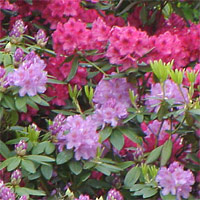Rhododendron

This popular genus includes the familiar spring-blooming rhododendrons and azaleas , both of which produce large clusters of colorful flowers.
About This Plant
Rhododendrons and azaleas perform best in regions with cool, moist summers. They bloom in late spring to early summer; flower colors include pink, red, violet, yellow, and white, depending on the species and variety. Size also varies considerably, from 1 or 2 feet to over 20 feet in height, so choose plants carefully to fit your garden situation. Although the distinction isn't clearcut, in general rhododendrons are evergreen, while most azaleas are deciduous (although there are evergreen types).
Special Features
Attracts hummingbirds
Shade tolerant
Planting Instructions
Plant in spring or fall. Space plants 2 to 6 feet apart, depending on the expected mature size of the plant. Dig a hole only as deep as the root ball and 2 to 3 times as wide. If your soil is in very poor condition, amend the soil you've removed from the hole with a small amount of compost. Otherwise don't amend it at all. Carefully remove the plant from the container and set it in the hole. Fill the hole half full with soil, then water it well to settle the soil and eliminate air pockets. Let the water drain, then fill the remainder of hole with soil and water thoroughly.
Care
Apply a layer of compost under the shrub each spring, spreading it out to the dripline (the area under the outermost branches). Add a 2-inch layer of mulch to retain moisture and control weeds, keeping mulch a few inches away from the trunk. Water plants during the summer if rainfall is less than 1 inch per week. In regions with severe winters, protect evergreen rhododendrons in the fall by wrapping burlap around them. Prune to remove dead, damaged, or diseased branches anytime. Prune to reduce height after flowering in spring. Rhododendrons will grow back from old wood.






 This popular genus includes the familiar spring-blooming rhododendrons and azaleas , both of which produce large clusters of colorful flowers.
This popular genus includes the familiar spring-blooming rhododendrons and azaleas , both of which produce large clusters of colorful flowers.